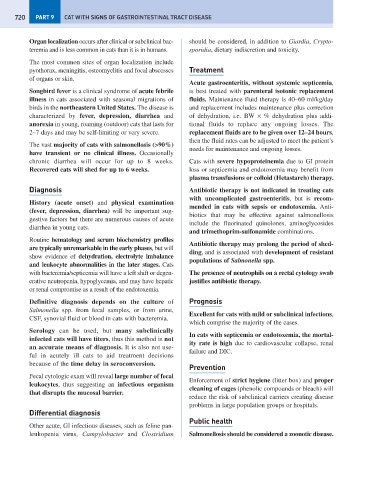Page 728 - Problem-Based Feline Medicine
P. 728
720 PART 9 CAT WITH SIGNS OF GASTROINTESTINAL TRACT DISEASE
Organ localization occurs after clinical or subclinical bac- should be considered, in addition to Giardia, Crypto-
teremia and is less common in cats than it is in humans. sporidia, dietary indiscretion and toxicity.
The most common sites of organ localization include
pyothorax, meningitis, osteomyelitis and focal abscesses Treatment
of organs or skin.
Acute gastroenteritis, without systemic septicemia,
Songbird fever is a clinical syndrome of acute febrile is best treated with parenteral isotonic replacement
illness in cats associated with seasonal migrations of fluids. Maintenance fluid therapy is 40–60 ml/kg/day
birds in the northeastern United States. The disease is and replacement includes maintenance plus correction
characterized by fever, depression, diarrhea and of dehydration, i.e. BW × % dehydration plus addi-
anorexia in young, roaming (outdoor) cats that lasts for tional fluids to replace any ongoing losses. The
2–7 days and may be self-limiting or very severe. replacement fluids are to be given over 12–24 hours,
then the fluid rates can be adjusted to meet the patient’s
The vast majority of cats with salmonellosis (>90%)
needs for maintenance and ongoing losses.
have transient or no clinical illness. Occasionally
chronic diarrhea will occur for up to 8 weeks. Cats with severe hypoproteinemia due to GI protein
Recovered cats will shed for up to 6 weeks. loss or septicemia and endotoxemia may benefit from
plasma transfusions or colloid (Hetastarch) therapy.
Diagnosis Antibiotic therapy is not indicated in treating cats
with uncomplicated gastroenteritis, but is recom-
History (acute onset) and physical examination
mended in cats with sepsis or endotoxemia. Anti-
(fever, depression, diarrhea) will be important sug-
biotics that may be effective against salmonellosis
gestive factors but there are numerous causes of acute
include the fluorinated quinolones, aminoglycosides
diarrhea in young cats.
and trimethoprim-sulfonamide combinations.
Routine hematology and serum biochemistry profiles
Antibiotic therapy may prolong the period of shed-
are typically unremarkable in the early phases, but will
ding, and is associated with development of resistant
show evidence of dehydration, electrolyte imbalance
populations of Salmonella spp.
and leukocyte abnormalities in the later stages. Cats
with bacteremia/septicemia will have a left shift or degen- The presence of neutrophils on a rectal cytology swab
erative neutropenia, hypoglycemia, and may have hepatic justifies antibiotic therapy.
or renal compromise as a result of the endotoxemia.
Definitive diagnosis depends on the culture of Prognosis
Salmonella spp. from fecal samples, or from urine,
Excellent for cats with mild or subclinical infections,
CSF, synovial fluid or blood in cats with bacteremia.
which comprise the majority of the cases.
Serology can be used, but many subclinically
In cats with septicemia or endotoxemia, the mortal-
infected cats will have titers, thus this method is not
ity rate is high due to cardiovascular collapse, renal
an accurate means of diagnosis. It is also not use-
failure and DIC.
ful in acutely ill cats to aid treatment decisions
because of the time delay in seroconversion.
Prevention
Fecal cytologic exam will reveal large number of fecal
Enforcement of strict hygiene (litter box) and proper
leukocytes, thus suggesting an infectious organism
cleaning of cages (phenolic compounds or bleach) will
that disrupts the mucosal barrier.
reduce the risk of subclinical carriers creating disease
problems in large population groups or hospitals.
Differential diagnosis
Public health
Other acute, GI infectious diseases, such as feline pan-
leukopenia virus, Campylobacter and Clostridium Salmonellosis should be considered a zoonotic disease.

